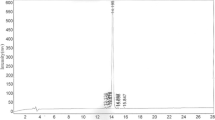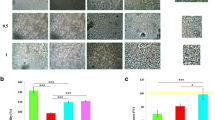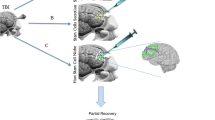Abstract
Spinal cord injury (SCI) in humans stayed a ruining and healless disorder. Since longer laminin motif (CQAASIKVAV (CQIK)) better mimics conformation of native region in active site than isoleucine-lysine-valine-alanine-valine (IKVAV) and resulted in improved cellular response so, for the first time in this study, CQIK bounded with two glycines spacer and (RADA)4 as a self-assembling peptide nanofiber backbone (-CQIK) was used. The purpose of this study was to investigate the role of -CQIK in neural differentiation of human endometrial-derived stromal cells (hEnSCs) in vitro, tubulin polymerization ex vivo, and assess the supportive effect of this hydrogel in an animal model of chronic SCI. Results disclosed that proton concentration has direct effect on hEnSCs membrane damage but not on neuroblastoma cells. However, cell viability of neuroblastoma encapsulated into -CQIK was higher than hEnSCs at the concentration of 0.125 % v/w. Gene expression data confirmed neurogenesis, TH over-expression, and glial fibrillary acidic protein (GFAP) suppression eventually through α6 and β1 integrin site. However, it revealed higher neurogenesis as compared to bone morrow homing peptides (BMHP). Although, Basso, Beattie, Bresnahan (BBB) score of chronic model of SCI in rat was higher than control and phosphate-buffered saline (PBS) group but significantly was less than BMHP group. However, -CQIK had induced neurite outgrowth and myelination and inhibited astrogliosis. Tubulin polymerization data using UV spectroscopy showed higher degree of polymerization. However, tubulin polymerization was dependent on nanofiber concentration. Based on our results, it might be concluded that peptidic nanofiber containing long motif of laminin holds great promise for spinal cord injury recovery with increment of neurogenesis and astrogliosis decrement.





Similar content being viewed by others
References
Macaya D, Spector M (2012) Injectable hydrogel materials for spinal cord regeneration: a review. Biomed Mater 7:012001
Perale G, Rossi F, Sundstrom E, Bacchiega S, Masi M et al (2011) Hydrogels in spinal cord injury repair strategies. ACS Chem Neurosci 2:336–345
Hejčl A, Lesný P, Přádný M, Michalek J, Jendelova P et al (2008) Biocompatible hydrogels in spinal cord injury repair. Physiol Res 57:S121–S132
Jain A, Kim Y-T, McKeon RJ, Bellamkonda RV (2006) In situ gelling hydrogels for conformal repair of spinal cord defects, and local delivery of BDNF after spinal cord injury. Biomaterials 27:497–504
Boudreau N, Jones P (1999) Extracellular matrix and integrin signalling: the shape of things to come. Biochem J 339:481–488
Zhang X-M, Huang G-W, Tian Z-H, Ren D-L, Wilson JX (2009) Folate stimulates ERK1/2 phosphorylation and cell proliferation in fetal neural stem cells. Nutr Neurosci 12:226–232
Mruthyunjaya S, Rumma M, Ravibhushan G, Anjali S, Padma S (2011) c-Jun/AP-1 transcription factor regulates laminin-1-induced neurite outgrowth in human bone marrow mesenchymal stem cells: role of multiple signaling pathways. FEBS Lett 585:1915–1922
Malinda KM, Nomizu M, Chung M, Delgado M, Kuratomi Y et al (1999) Identification of laminin α1 and β1 chain peptides active for endothelial cell adhesion, tube formation, and aortic sprouting. FASEB J 13:53–62
Yamamura K, Kibbey M, Jun S, Kleinman H (1993) Effect of matrigel and laminin peptide YIGSR on tumor growth and metastasis. 259–265
Yoshida N, Ishii E, Nomizu M, Yamada Y, Mohri S et al (1999) The laminin-derived peptide YIGSR (Tyr–Ile–Gly–Ser–Arg) inhibits human pre-B leukaemic cell growth and dissemination to organs in SCID mice. Br J Cancer 80:1898
Takagi Y, Nomizu M, Gullberg D, MacKrell AJ, Keene DR et al (1996) Conserved neuron promoting activity in drosophila and vertebrate laminin α1. J Biol Chem 271:18074–18081
Tysseling-Mattiace VM, Sahni V, Niece KL, Birch D, Czeisler C et al (2008) Self-assembling nanofibers inhibit glial scar formation and promote axon elongation after spinal cord injury. J Neurosci 28:3814–3823
Lampe KJ, Heilshorn SC (2012) Building stem cell niches from the molecule up through engineered peptide materials. Neurosci Lett 519:138–146
Chambers BJ, Klein NW, Conrad SH, Ruppenthal GC, Sackett GP et al (1995) Reproduction and sera embryotoxicity after immunization of monkeys with the laminin peptides YIGSR, RGD, and IKVAV. Proc Natl Acad Sci 92:6818–6822
Yamada M, Kadoya Y, Kasai S, Kato K, Mochizuki M et al (2002) Ile-Lys-Val-Ala-Val (IKVAV)-containing laminin α1 chain peptides form amyloid-like fibrils. FEBS Lett 530:48–52
Kikkawa Y, Hozumi K, Katagiri F, Nomizu M, Kleinman HK et al (2013) Laminin-111-derived peptides and cancer. Cell Adhes Migr 7:150–159
Silva GA, Czeisler C, Niece KL, Beniash E, Harrington DA et al (2004) Selective differentiation of neural progenitor cells by high-epitope density nanofibers. Science 303:1352–1355
Berry CC, Charles S, Wells S, Dalby MJ, Curtis AS (2004) The influence of transferrin stabilised magnetic nanoparticles on human dermal fibroblasts in culture. Int J Pharm 269:211–225
Massumi M, Abasi M, Babaloo H, Terraf P, Safi M et al (2011) The effect of topography on differentiation fates of matrigel-coated mouse embryonic stem cells cultured on PLGA nanofibrous scaffolds. Tissue Eng A 18:609–620
Gelain F, Bottai D, Vescovi A, Zhang S (2006) Designer self-assembling peptide nanofiber scaffolds for adult mouse neural stem cell 3-dimensional cultures. PLoS One 1:e119
Zhang ZX, Zheng QX, Wu YC, Hao DJ (2010) Compatibility of neural stem cells with functionalized self-assembling peptide scaffold in vitro. Biotechnol Bioprocess Eng 15:545–551
Yang H, Qu T, Yang H, Wei L, Xie Z et al (2013) Self-assembling nanofibers improve cognitive impairment in a transgenic mice model of Alzheimer’s disease. Neurosci Lett 556:63–68
Lévesque SG, Shoichet MS (2006) Synthesis of cell-adhesive dextran hydrogels and macroporous scaffolds. Biomaterials 27:5277–5285
Shaw D, Shoichet MS (2003) Toward spinal cord injury repair strategies: peptide surface modification of expanded poly (tetrafluoroethylene) fibers for guided neurite outgrowth in vitro. J Craniofac Surg 14:308–316
Ebrahimi-Barough S, Kouchesfahani HM, Ai J, Massumi M (2013) Differentiation of human endometrial stromal cells into oligodendrocyte progenitor cells (OPCs). J Mol Neurosci 51:265–273
Tavakol S, Modarres Mousavi SM, Masummi M, Amani A, Rezayat SM et al (2014) The effect of noggin supplementation in Matrigel nanofiber-based cell culture system for derivation of neural-like cells from human endometrial-derived stromal cells. J Biomed Mater Res A 103:1–7
Medistem (2011) Medistem receives FDA approval to begin clinical trial in USA with ERC stem cells. San Diego
Tavakol S, Aligholi H, Gorji A, Eshaghabadi A, Hoveizi E et al (2014) Thermogel nanofiber induces human endometrial-derived stromal cells to neural differentiation: in vitro and in vivo studies in rat. J Biomed Mater Res A 102:4590–4597
Dadras A, Riazi GH, Afrasiabi A, Naghshineh A, Ghalandari B et al (2013) In vitro study on the alterations of brain tubulin structure and assembly affected by magnetite nanoparticles. JBIC J Biol Inorg Chem 18:357–369
Gheshlaghi ZN, Riazi GH, Ahmadian S, Ghafari M, Mahinpour R (2008) Toxicity and interaction of titanium dioxide nanoparticles with microtubule protein. Acta Biochim Biophys Sin 40:777–782
Holtz A, Nyström B, Gerdin B (1989) Blocking weight-induced spinal cord injury in rats: effects of TRH or naloxone on motor function recovery and spinal cord blood flow. Acta Neurol Scand 80:215–220
Basso DM, Beattie MS, Bresnahan JC (1995) A sensitive and reliable locomotor rating scale for open field testing in rats. J Neurotrauma 12:1–21
Shivachar A (2008) Isolation and culturing of glial, neuronal and neural stem cell types encapsulated in biodegradable peptide hydrogel. Topics in Tissue Eng 4
Tavakol S (2014) Acidic pH derived from cancer cells may induce failed reprogramming of normal differentiated cells adjacent tumor cells and turn them into cancer cells. Med Hypotheses 83:668–672
Wang X, Zhao Y, Xiao Z, Chen B, Wei Z et al (2009) Alternative translation of OCT4 by an internal ribosome entry site and its novel function in stress response. Stem Cells 27:1265–1275
Tavakol S, Saber R, Hoveizi E, Aligholi H, Ai J, et al. (2015) Chimeric self-assembling nanofiber containing bone marrow homing peptide’s motif induces motor neuron recovery in animal model of chronic spinal cord injury; an in vitro and in vivo investigation. Mol Neurobiol: 1–11
Noble M, Smith J, Power J, MAYER-PRÖSCHEL M (2003) Redox state as a central modulator of precursor cell function. Ann N Y Acad Sci 991:251–271
Horie N, So K, Moriya T, Kitagawa N, Tsutsumi K et al (2008) Effects of oxygen concentration on the proliferation and differentiation of mouse neural stem cells in vitro. Cell Mol Neurobiol 28:833–845
Morrison SJ, Csete M, Groves AK, Melega W, Wold B et al (2000) Culture in reduced levels of oxygen promotes clonogenic sympathoadrenal differentiation by isolated neural crest stem cells. J Neurosci 20:7370–7376
Rosen P, Boulton M, Moriarty P, Khaliq A, McLeod D (1991) Effect of varying oxygen concentrations on the proliferation of retinal microvascular cells in vitro. Exp Eye Res 53:597–601
Holzwarth C, Vaegler M, Gieseke F, Pfister SM, Handgretinger R et al (2010) Low physiologic oxygen tensions reduce proliferation and differentiation of human multipotent mesenchymal stromal cells. BMC Cell Biol 11:11
Tsai T-T, Guttapalli A, Oguz E, Chen L-H, Vaccaro AR et al (2007) Fibroblast growth factor-2 maintains the differentiation potential of nucleus pulposus cells in vitro: implications for cell-based transplantation therapy. Spine 32:495–502
Balgude A, Yu X, Szymanski A, Bellamkonda R (2001) Agarose gel stiffness determines rate of DRG neurite extension in 3D cultures. Biomaterials 22:1077–1084
Flanagan LA, Ju Y-E, Marg B, Osterfield M, Janmey PA (2002) Neurite branching on deformable substrates. Neuroreport 13:2411
Georges PC, Miller WJ, Meaney DF, Sawyer ES, Janmey PA (2006) Matrices with compliance comparable to that of brain tissue select neuronal over glial growth in mixed cortical cultures. Biophys J 90:3012–3018
Saha K, Keung AJ, Irwin EF, Li Y, Little L et al (2008) Substrate modulus directs neural stem cell behavior. Biophys J 95:4426–4438
Leipzig ND, Shoichet MS (2009) The effect of substrate stiffness on adult neural stem cell behavior. Biomaterials 30:6867–6878
Pan L, North HA, Sahni V, Jeong SJ, Mcguire TL et al (2014) β1-integrin and integrin linked kinase regulate astrocytic differentiation of neural stem cells. PLoS One 9:e104335
Taraballi F, Natalello A, Campione M, Villa O, Doglia SM, et al. (2010) Glycine-spacers influence functional motifs exposure and self-assembling propensity of functionalized substrates tailored for neural stem cell cultures. Front Neuroeng 3
Tamada M, Sheetz MP, Sawada Y (2004) Activation of a signaling cascade by cytoskeleton stretch. Dev Cell 7:709–718
Engler AJ, Sen S, Sweeney HL, Discher DE (2006) Matrix elasticity directs stem cell lineage specification. Cell 126:677–689
Han R, Tu L, Yang M, Xu T, Ma Y et al (2013) Combined application of neural stem cell and self-assembly isoleucine-lysine-valine-alanine-valine nanofiber gel transplantation in the promotion of function recovery of spinal cord injury in rats. Zhonghua yi xue za zhi 93:1669–1673
Kleinman HK, Weeks BS, Cannon FB, Sweeney TM, Sephel GC et al (1991) Identification of a 110-kDa nonintegrin cell surface laminin-binding protein which recognizes an a chain neurite-promoting peptide. Arch Biochem Biophys 290:320–325
Kibbey MC, Jucker M, Weeks BS, Neve RL, Van Nostrand WE et al (1993) Beta-amyloid precursor protein binds to the neurite-promoting IKVAV site of laminin. Proc Natl Acad Sci 90:10150–10153
Acknowledgments
This work was supported by grant from Iran National Science Foundation (INSF) for the financial support (grant number 92022532) and Tehran University of Medical Sciences, (TUMS) Tehran, Iran Grant Number (93-01-87-23996).
Author information
Authors and Affiliations
Corresponding authors
Rights and permissions
About this article
Cite this article
Tavakol, S., Saber, R., Hoveizi, E. et al. Self-Assembling Peptide Nanofiber Containing Long Motif of Laminin Induces Neural Differentiation, Tubulin Polymerization, and Neurogenesis: In Vitro, Ex Vivo, and In Vivo Studies. Mol Neurobiol 53, 5288–5299 (2016). https://doi.org/10.1007/s12035-015-9448-z
Received:
Accepted:
Published:
Issue Date:
DOI: https://doi.org/10.1007/s12035-015-9448-z




